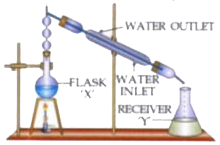1. Separating miscible liquidsa. Filtration and evaporation2. Separating immiscible liquidsb. Sedimentation, filtration and evaporation3. Separating CaCO3 and NaClc. Separating funnel4. Separating sand, saw dust and saltd. Fractional distillation
The correct Answer is:1. d 2. c 3. a 4. b
To solve the question of matching the methods of separation with the appropriate mixtures, we can follow these steps:
1. Identify the first statement:
- The first statement is about "Separating miscible liquids".
- Matching Method: The correct method for separating miscible liquids is Fractional Distillation.
- Match: 1 → d
2. Identify the second statement:
- The second statement is about "Separating immiscible liquids".
- Matching Method: The appropriate method for this is a Separating Funnel.
- Match: 2 → c
3. Identify the third statement:
- The third statement is about "Separating CaCO₃ and NaCl".
- Matching Method: This can be done through Filtration and Evaporation. First, filter to remove CaCO₃, then evaporate to obtain NaCl.
- Match: 3 → a
4. Identify the fourth statement:
- The fourth statement is about "Separating sand, sawdust, and salt".
- Matching Method: This involves Sedimentation, followed by Filtration, and finally Evaporation to separate the components.
- Match: 4 → b
Final Matches:
1. Separating miscible liquids → d. Fractional distillation
2. Separating immiscible liquids → c. Separating funnel
3. Separating CaCO₃ and NaCl → a. Filtration and evaporation
4. Separating sand, sawdust, and salt → b. Sedimentation, filtration, and evaporation
- The first statement is about "Separating miscible liquids".
- Matching Method: The correct method for separating miscible liquids is Fractional Distillation.
- Match: 1 → d
- The second statement is about "Separating immiscible liquids".
- Matching Method: The appropriate method for this is a Separating Funnel.
- Match: 2 → c
- The third statement is about "Separating CaCO₃ and NaCl".
- Matching Method: This can be done through Filtration and Evaporation. First, filter to remove CaCO₃, then evaporate to obtain NaCl.
- Match: 3 → a
- The fourth statement is about "Separating sand, sawdust, and salt".
- Matching Method: This involves Sedimentation, followed by Filtration, and finally Evaporation to separate the components.
- Match: 4 → b
1. Separating miscible liquids → d. Fractional distillation
2. Separating immiscible liquids → c. Separating funnel
3. Separating CaCO₃ and NaCl → a. Filtration and evaporation
4. Separating sand, sawdust, and salt → b. Sedimentation, filtration, and evaporation
Topper's Solved these Questions
- BOOK - ICSECHAPTER - ELEMENTS, COMPOUNDS AND MIXTURES EXERCISE - EXERCISES (Multiple choice questions)5videos
ELEMENTS, COMPOUNDS AND MIXTURES
- BOOK - ICSECHAPTER - ELEMENTS, COMPOUNDS AND MIXTURES EXERCISE - EXERCISES (True or False)5videos
ELEMENTS, COMPOUNDS AND MIXTURES
- BOOK - ICSECHAPTER - ELEMENTS, COMPOUNDS AND MIXTURES EXERCISE - Test Yourself-2 (Fill in the blanks)5videos
ELEMENTS, COMPOUNDS AND MIXTURES
- BOOK - ICSECHAPTER - ELEMENTS, COMPOUNDS & MIXTURESEXERCISE - OBJECTIVE TYPE QUESTIONS (Elements, Compounds & Mixtures)17videos
ELEMENTS, COMPOUNDS & MIXTURES
- BOOK - ICSECHAPTER - HYDROGEN EXERCISE - Think and answer3videos
HYDROGEN
Similar Questions
Miscible liquids are separated by using a separating funnel.
View SolutionExplain the techniques of separation involved in
a. filtration b. evaporation.View Solution1.Separating ammonium chloride from salt(a)Filtration2.Separating paneer from whey(b)Fractional distillation3.Separating flour from bran(c)Centrifugation4.Separating butter from milk(d)Sublimation5.Separating petrol and diesel from crude oil(e)Sieving
View SolutionTwo volatile and miscible liquids can be separated by fractional distillations into pure components under the condition
View SolutionMiscible liquids are separated by the process of _____ distillation.
View SolutionThe diagram represents fractional distillation for separation of mixtures. Answer the following: Can two immiscible liquids be separated by this process.
 View Solution
View SolutionThe following statements is true only under some specific conditions. Write the condition for it "Two volatile and miscible liquids can be separated by fractional distillation into pure components."
View SolutionFractional distillation is suitable for separation of miscible liquids with a boiling point difference of about 25 K or less. What part of fractional distillation apparatus makes it efficient and possess an advantage over a simple distillation process. Explain using a diagram.
View SolutionTwo liquids A and B form type II non-ideal solution which shows a minimum in its temperature-molefraction plot (T-X diagram). Can the two liquids be completely separated by fractional distillation?
View SolutionThe diagram represents fractional distillation for separation of mixtures. Answer the following: Separation of liquids by this process is based on which physical property.
 View Solution
View Solution

